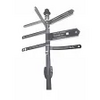A utility where users can change LED colors or link their MSI hardware together
A utility where users can change LED colors or link their MSI hardware together
Vote: (2 votes)
Program license: Free
Version: 3.0
Works under: Windows
Vote:
Program license
(2 votes)
Free
Version
3.0
Works under:
Windows
Pros
- Wide-ranging compatibility with MSI products and peripherals
- Supports non-MSI hardware with standard 4-pin connectors
- Synchronization features like Mystic Light Sync and Ambient Link
- Intuitive user interface for easy customization
Cons
- Some features may be limited to MSI-centric ecosystems
- Hardware support for third-party components is less comprehensive compared to MSI products
Illuminate Your Rig with MSI Mystic Light
MSI Mystic Light stands as a beacon of customization for PC enthusiasts, a testament to the RGB trend that has swept the world of computer hardware. As a premier offering from MSI, a leader in the PC components and gaming hardware sector, Mystic Light serves as an intuitive RGB configuration tool tailored specifically for its ecosystem of products. The software's versatility also extends to a wide range of compatible third-party hardware, allowing users to tweak and fine-tune their lighting to create aesthetic harmony across their entire setup.
Comprehensive Compatibility
MSI Mystic Light caters to an extensive selection of hardware, from motherboards like the B-Series and Z-Series to the acclaimed GAMING and VENTUS graphics card linups. It also encompasses the OPTIX gaming monitors and a select range of gaming laptops. However, the reach of Mystic Light doesn't end there. It envelops peripherals such as the MAG Max PC case fans, the MAG CORELIQUID CPU coolers, gaming mice, keyboards, and even LED light strips.
For hardware not under the MSI brand, Mystic Light maintains functionality, much to the delight of users, thanks to its support for 4-pin RGB connectors. These connectors are the industry standard and easily interface with motherboard RGB headers or through RGB controller hubs. The ability to manage lighting for devices outside the MSI umbrella marks Mystic Light as a versatile option in a field populated with proprietary solutions like Asus Aura Sync and Gigabyte RGB Fusion.
Advanced Features and Synchronization
One of the more remarkable features of Mystic Light is the Mystic Light Sync. This synergy-driven feature allows for lighting themes to be synchronized across various devices, achieving an elegant and cohesive visual display. Beyond static synchronization, there's the Ambient Link, which brings a dynamic lighting experience aligned with certain games. This gaming-centric innovation pushes the boundaries of immersion, coordinating lighting effects with in-game actions and environments for a riveting gaming session.
User Experience and Interface
Navigating through MSI Mystic Light's interface is a satisfactory experience. The UI is designed with simplicity and usability in mind, ensuring that both novices and experienced users can engage with the software without a steep learning curve. Users can select between multiple lighting effects and colors, customizing each compatible component to match their visual tastes. Whether it's a soothing wave of colors or a pulsating stroboscopic effect, the manipulation of lighting aesthetics is just a few clicks away.
Final Considerations
In essence, MSI Mystic Light is a comprehensive tool for those invested in the MSI ecosystem and beyond. While its affinity for MSI products is clear, its interoperability with other brands makes it a noteworthy contestant in the RGB software arena. The software unlocks the potential to create mesmerizing illumination effects across all RGB-capable hardware, enhancing the overall appearance of your gaming rig or workstation.
Pros
- Wide-ranging compatibility with MSI products and peripherals
- Supports non-MSI hardware with standard 4-pin connectors
- Synchronization features like Mystic Light Sync and Ambient Link
- Intuitive user interface for easy customization
Cons
- Some features may be limited to MSI-centric ecosystems
- Hardware support for third-party components is less comprehensive compared to MSI products




